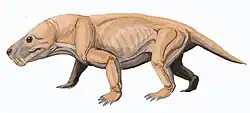Lycideops
Lycideops is an extinct genus of therocephalians from the Late Permian of South Africa. The type species is Lycideops longiceps, named in 1931 by South African paleontologist Robert Broom. Fossils of Lycideops come from the Dicynodon Assemblage Zone of the Beaufort Group.[1] Lycideops is a member of the family Lycideopidae. Like other lycideopids, Lycideops has a long snout.[2]
| Lycideops Temporal range: Late Permian | |
|---|---|
| Scientific classification | |
| Domain: | Eukaryota |
| Kingdom: | Animalia |
| Phylum: | Chordata |
| Clade: | Synapsida |
| Clade: | Therapsida |
| Clade: | †Therocephalia |
| Family: | †Lycideopidae |
| Genus: | †Lycideops Broom, 1931 |
| Type species | |
| †Lycideops longiceps Broom, 1931 | |
Phylogeny
Lycideops has been included in several phylogenetic analyses, including those of Huttenlocker (2009), Huttenlocker et al. (2011), and Sigurdsen et al. (2012). All place Lycideops within the advanced therocephalian clade Baurioidea. Huttenlocker (2009) and Huttenlocker et al. (2011) found it to group with Regisaurus and Scaloposaurus as shown in the cladogram below:[3][4]
| Baurioidea |
| ||||||||||||||||||||||||||||||||||||||||||||||||
The analysis of Sigurdsen et al. (2012) came to a different result, grouping Lycideops with Tetracynodon and Choerosaurus. The clade including these three genera was called Lycideopidae, and Lycideops was the most basal member of the group. Characteristics that unite Lycideops with Tetracynodon and Choerosaurus include the presence of five incisors on each side of the lower jaw (a derived characteristic given that most other eutherocephalians have four), a lacrimal bone that touches the nasal bone, and a contact between the maxilla and the vomer in the palate. Below is a cladogram from the analysis:[2]
| Baurioidea |
| ||||||||||||||||||||||||||||||||||||||||||
References
- Abdala, F.; Rubidge, B. S.; Van Den Heever, J. (2008). "The Oldest Therocephalians (Therapsida, Eutheriodontia) and the Early Diversification of Therapsida". Palaeontology. 51 (4): 1011. doi:10.1111/j.1475-4983.2008.00784.x.
- Sigurdsen, T.; Huttenlocker, A. K.; Modesto, S. P.; Rowe, T. B.; Damiani, R. (2012). "Reassessment of the morphology and paleobiology of the therocephalian Tetracynodon darti (Therapsida), and the phylogenetic relationships of Baurioidea". Journal of Vertebrate Paleontology. 32 (5): 1113. doi:10.1080/02724634.2012.688693.
- Huttenlocker, A. (2009). "An investigation into the cladistic relationships and monophyly of therocephalian therapsids (Amniota: Synapsida)". Zoological Journal of the Linnean Society. 157 (4): 865–891. doi:10.1111/j.1096-3642.2009.00538.x.
- Huttenlocker, A. K.; Sidor, C. A.; Smith, R. M. H. (2011). "A new specimen of Promoschorhynchus (Therapsida: Therocephalia: Akidnognathidae) from the Lower Triassic of South Africa and its implications for theriodont survivorship across the Permo-Triassic boundary". Journal of Vertebrate Paleontology. 31 (2): 405. doi:10.1080/02724634.2011.546720.




